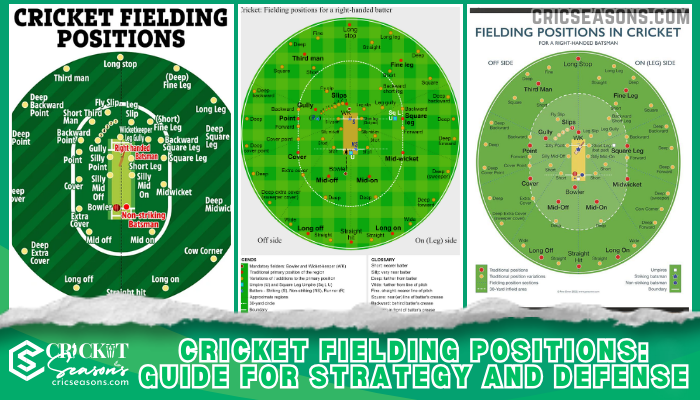Cricket Fielding positions in cricket are as essential as batting and bowling. Each player’s placement is critical for both defensive and offensive strategies. A well-set field can trap a batsman, creating pressure and forcing mistakes. Understanding the layout of the cricket field and how each position works can greatly enhance your game knowledge. The cricket field is split into two main sections: the off-side and the leg-side. The captain, with advice from the bowler, strategically places fielders in various positions to either stop runs or take catches.
Contents
Understanding the Basics of Cricket Fielding Positions
To grasp fielding positions fully, you need to understand the cricket field layout. The two sides of the field, off-side and leg-side, serve as the basis for naming the fielding positions. The off-side is the area in front of the batsman when facing the bowler, while the leg-side refers to the side behind the batsman’s legs.
Most fielders are placed on the off-side, as most shots are directed there. Fielders’ positions are often described using terms like “silly,” “short,” “deep,” and “long” to indicate their distance from the batsman. For example, a “silly point” fielder is very close to the batsman, while a “deep point” is near the boundary.
Key Close-in Fielding Positions (Catching)
Close-in fielders play a pivotal role in catching edged balls off the bat. These positions are crucial, especially against fast bowlers or spinners. Slip fielders stand behind the batsman, next to the wicketkeeper, ready to catch balls that fly off the edge of the bat.
There can be multiple slips, like first, second, and third, depending on the level of aggression. Silly point and short leg are even closer to the batsman. They need quick reflexes, as they are positioned to catch deflections that come off fast deliveries or when the batsman misjudges a shot.
In-Field Positions (Stopping Singles)
In-field positions are designed to cut off quick singles and prevent easy runs. Point and cover are key fielding spots on the off-side, often placed to stop powerful shots played in this direction. Point is located square of the wicket, while cover stands wider and slightly deeper.
Both positions require sharp fielders who can dive and react quickly to stop the ball. On the leg-side, mid-on and mid-off are responsible for intercepting straight drives and shots played down the ground. These positions are also crucial for stopping quick singles and maintaining pressure on the batsmen.
Outfield Positions (Boundary Protection)
Outfield positions are primarily focused on preventing boundaries and stopping big shots. Third man and fine leg are located near the boundary, behind square on the off-side and leg-side, respectively. These fielders are critical for cutting off glances, edges, and flicks that might otherwise reach the boundary.
On the leg-side, deep square leg and deep mid-wicket are often placed to intercept aggressive shots, especially in limited-overs cricket. Long-on and long-off stand on opposite sides of the pitch near the boundary to stop aerial shots and contain big-hitting batsmen.
Specialized Positions
Some fielding positions are rarely used but highly specialized for certain match situations. Fly slip, for instance, is placed deeper than traditional slips and catches balls glancing off the bat when there are no regular slips in play. On the leg side, cow corner is located slightly in front of deep mid-wicket.
This position is often used in limited-overs formats, as many batsmen target this area with power shots. Lastly, long stop is an old-fashioned position, rarely seen in modern cricket, located directly behind the wicketkeeper to stop balls that escape both the keeper and slips.
Strategic Field Placements
Field placements are not static; they adapt to the match situation and format. In limited-overs cricket, for example, powerplay restrictions force teams to keep a certain number of fielders inside a 30-yard circle, which drastically affects field settings. During these periods, captains often use attacking positions like slips, mid-off, and mid-on to pressure the batsmen.
As the game progresses, defensive positions like deep point and deep square leg are employed to save runs. In longer formats like Test cricket, captains can be more creative with aggressive field settings, using multiple slips, short leg, and silly point to target early wickets.
FAQ
1. What are the most important fielding positions in cricket?
Ans: The most critical fielding positions include the slips, point, mid-on, mid-off, and square leg. These positions are involved in both stopping runs and taking catches. Slips are positioned close behind the batsman, while point and cover handle powerful shots on the off-side.
Mid-on and mid-off are stationed closer to the bowler to block straight drives. These positions change based on the format and game strategy.
2. How do fielding positions change in limited-overs formats?
Ans: In limited-overs cricket, especially during powerplays, only two fielders are allowed outside the 30-yard circle. As a result, attacking positions like slips are more common early in the game. Once powerplays end, captains tend to move players into the outfield, such as deep mid-wicket, long-on, and deep square leg, to stop boundaries and save runs.
3. What’s the role of the wicketkeeper?
Ans: The wicketkeeper is the only fielder allowed to wear gloves and stands directly behind the stumps. They catch balls bowled past the batsman, stump out players, and provide crucial fielding guidance to bowlers and captains. The wicketkeeper also plays a key role in close catches and run-outs.
Wrapping Up
Fielding positions are the backbone of any cricket team’s defense strategy. Understanding each role on the field—from close-in catchers to boundary protectors can significantly improve both a player’s and a viewer’s appreciation of the game. Captains constantly adjust these positions based on the game situation, ensuring that the team’s fielding setup maximizes chances for wickets and minimizes runs.
Whether you’re new to cricket or a seasoned fan, knowing the importance of positions like slips, mid-off, and deep mid-wicket can deepen your understanding of this intricate sport. Master these fielding setups, and you’ll begin to see how much of a game-changer they can be!
